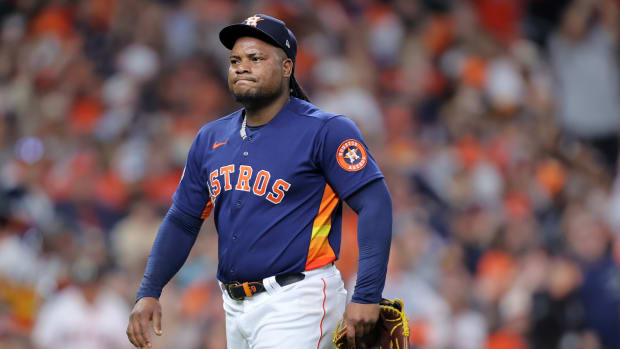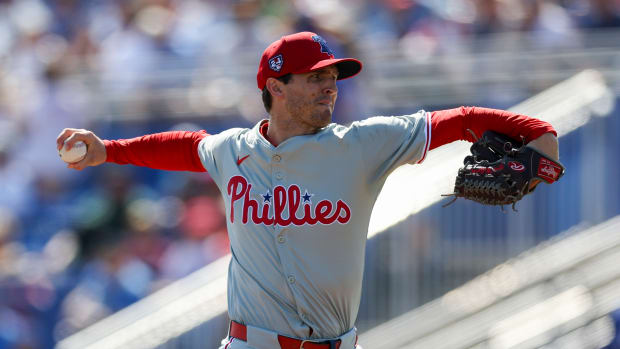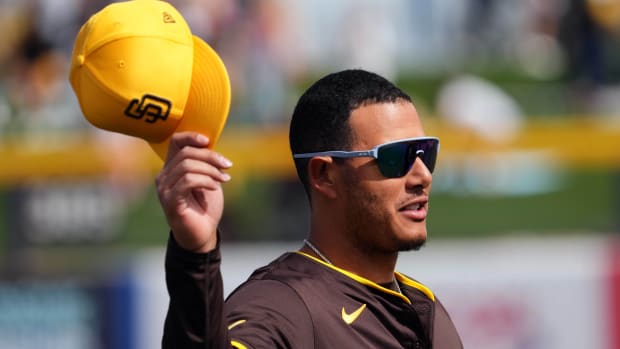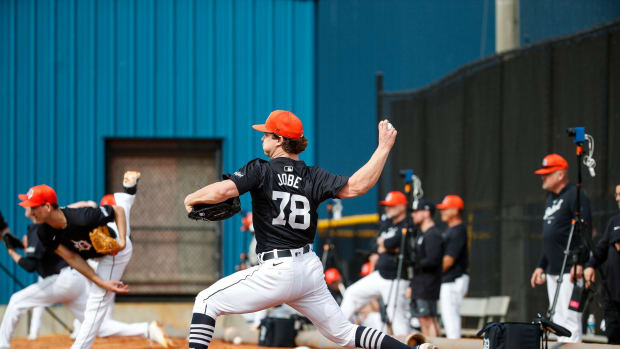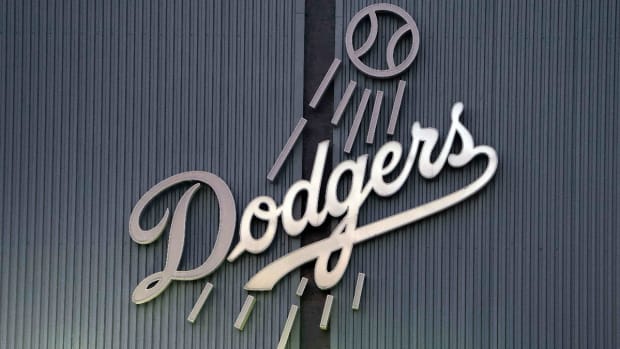Dodgers add to infield stockpile with deal for Cuban star Hector Olivera
The pursuit of Hector Olivera was already surrounded by mystery, but now the plot has thickened. The soon-to-be–30-year-old Cuban infielder has agreed to a six-year, $62.5 million deal with the Dodgers, perhaps the team best positioned to absorb the risks he presents. Los Angeles is already poised to set a major league record with a $268 million payroll, albeit one that lacks an immediate opening for Olivera, a pricey player whose health and representation issues scared away potential suitors.
Sports Illustrated's 2015 MLB season preview rankings
The deal—which has not yet become official because Olivera has not yet passed his physical—includes a clause calling for a seventh season at $1 million if Olivera undergoes Tommy John surgery, apparently a possibility given rumors that he has a damaged ulnar collateral ligament. It's the largest commitment from the Dodgers since Andrew Friedman took over as club president last fall, eclipsing the four-year, $48 million deal for Brandon McCarthy in December. Because of Olivera's age and experience, his contract, which includes a massive $28 million signing bonus, does not count against international spending limits, but it does count against the luxury tax. Via MLB's methodology, which uses the average annual value of player contracts, plus earned incentives and additional benefits, the team had a $277,737,083 payroll last year and was taxed at a 30% rate on the money that exceeded the $189 million tax threshold. Los Angeles thus had to pay a $26.6 million tax.
That figure will increase in 2015, as will the team’s marginal tax rate, to 40%. The current $268.3 million figure, which comes via Cot’s Contracts, includes actual '15 salaries, but not that of Olivera, since it’s unofficial and its structure is yet unknown; based on its AAV, the Associated Press estimated that it would add $4.17 million to the team’s tax bill.
In terms of overall size, Olivera's deal ranks behind those of recent Cuban defectors Rusney Castillo (seven years, $72.5 million from the Red Sox), Yasmany Tomas (six years, $68.5 million from the Diamondbacks) and Jose Abreu (six years and $68 million from the White Sox). It’s the Dodgers’ largest to a Cuban defector, eclipsing the seven-year, $42 million to which the team signed the much younger Yasiel Puig in 2012.
Castillo, Tomas lead group of must-watch Cuban rookies in 2015
After spending 10 years with Santiago de Cuba in Serie Nacional, Cuba's top professional league, Olivera defected in September 2014 and established residency in Haiti. He made a positive impression in front of a large group of scouts and major league executives at a showcase in the Dominican Republic in February and was officially declared a free agent by MLB in the first week of March. Concerns about his medical history scared away some teams: Olivera lost part of his '11–12 season and all of his '12–13 season to a bout of thrombosis in the biceps of his left (non-throwing) arm; rumors of his damaged UCL concern his right arm.
As if that weren't enough, Olivera changed representation shortly after being declared a free agent, but Rudy& Santin, his original trainer/negotiation representative (who is not certified by the MLB Players Association), and new agent Greg Genske both continued to field offers from teams. Santin was said to be expecting a deal in excess of $70 million, but reports from several anonymous executives suggested his deal would wind up in the $45–50 million range. When I checked in on March 10, the Braves, Padres and Dodgers were the teams most heavily linked to Olivera, with the Athletics, Giants and Marlins having fallen out of the running.
• VERDUCCI: Six losing teams who could be playoff surprises in 2015
In the abstract, it's no surprise that the Dodgers won out for Olivera's services given their seemingly bottomless reserve of resources, but with Howie Kendrick and Juan Uribe set to open as their starting second and third baseman, respectively, it's not clear where Olivera will play. Via FOX Sports' Ken Rosenthal, the Dodgers themselves haven't decided:
The 31-year-old Kendrick, who was acquired from the Angels in December to replace the traded Dee Gordon, and the 36-year-old Uribe, who is heading into his fifth season with the Dodgers, are both pending free agents, and relatively affordable ones at that, making $9.5 million and $6.5 million this year, respectively. Both are coming off productive seasons and offer strong defense to go with above-average offense: Kendrick hit .293/.347/.397 for a 115 OPS+ and seven Defensive Runs Saved en route to 5.4 WAR last year, and Uribe hit .311/.337/.440 with an NL-high 17 DRS en route to 4.0 WAR.
Kendrick will almost certainly generate a compensatory draft pick via a qualifying offer next winter. The same probably can't be said for Uribe—a Ned Colletti signing who has put up two strong seasons in a row after two sub-replacement level ones—given his age, but he has emerged as a particularly important clubhouse presence, as well as a mentor to players as disparate as Puig and Hyun-Jin Ryu. Reigning NL MVP and Cy Young winner Clayton Kershaw thanked Uribe in his acceptance speech for the latter award: "Thank you for making me laugh. You are one of the most important people in our clubhouse."
Red Sox land infielder Yoan Moncada, off-season's top Cuban prospect
Beyond Kendrick and Uribe, the Dodgers have the versatile 30-year-old Justin Turner, who’s coming off a stellar .340/.404/.493 showing in a part-time role; slick-fielding 29-year-old Darwin Barney, who hit a combined .241/.300/.342 for the Dodgers and Cubs; and 23-year-old Kiké Hernandez, who hit a combined .248/.321/.421 for the Astros and Marlins. Further crowding the picture are a pair of Cuban infielders left over from the Colletti regime in Alex Guerrero and Erisbel Arruebarrena, who combined to make 58 plate appearances for the Dodgers last year while earning the first $5.5 million of a guaranteed $53 million.
Guerrero missed seven weeks last year after Albuquerque teammate Miguel Olivobig off part of his left ear in a dugout skirmish, a shocking and untimely blow that came just as Uribe hit the disabled list with a hamstring injury. Now 28 years old, Guerrero—who hit .333/.373/.621 in 308 minor league PA last year, his first stateside—is making a strong bid to stick by playing shortstop, his regular position during his seven seasons in Serie Nacional but one that he played in just seven minor league games last year.
Guerrero’s four-year, $28 million deal includes a provision allowing him to become a free agent at season's end if he's traded, though he could play his way into the team’s plans as Kendrick’s successor. Olivera would then shift to third, with prospect Corey Seager, who’s starting his age-21 season at Double A, taking over shortstop from Jimmy Rollins, a December acquisition who will be a free agent after the season. The 25-year-old Arruebarrena, meanwhile, hit a combined .259/.304/.417 in 272 minor league PA and was outrighted off the Dodgers' 40-man roster in January after clearing waivers, meaning that there were no takers for the remainder of his five-year, $25 million deal.
• SI WIRE: Time Warner Cable could lose $1 billion in Dodgers TV deal
Given all of that, the Dodgers clearly have the depth to withstand the possibility of Olivera needing Tommy John surgery, from which position players generally take between six and nine months to return. And while he's been cleared to sign a contract by MLB, he still needs to obtain a visa in order to play, which isn't guaranteed to happen by Opening Day. At full health, however, Olivera is a more complete player than Guerrero, Arruebarrena or any of the team’s other backup options; at the time he defected, Baseball America's Ben Badler called the 6'2", 220-pound second baseman "one of the most well-rounded players in Cuba, showing a combination of hitting ability, power, speed and size."
Palmeiro, Tiant, Chapman headline all-time All-Cuba team
Olivera (whose father, Hector Olivera Sr., also starred in Serie Nacional) hit a combined .323/.407/.505 in his 10 seasons in Cuba, posting an OPS above 1.000 three times in the five seasons from 2007 to '12, with .924 as his lowest mark in that span. He starred on the international stage, too, including the 2007 and 2009 Baseball World Cups, the 2008 Olympics, the 2009 World Baseball Classic and the 2010 Intercontinental Cup (where he won MVP honors), but he missed the 2013 World Baseball Classic due to thrombosis. That injury curtailed what was turning out to be Olivera's best season (.341/.468/.626 with 17 home runs in 60 games) and required him to take blood thinners, which prevented him from playing in '12–13. He hit .316/.412/.474 with seven home runs in 273 PA in '13–14, but spent most of the season as a designated hitter, playing just 29 games at second base.
After attending his February workouts in the Dominican Republic, FanGraphs analyst Kiley McDaniel filed a thorough report on Olivera, including current and future grades on the 28–80 scouting scale:
Hit: 45/55, Game Power: 45/50+, Raw Power: 55/55, Speed: 55/55, Field: 50/50, Throw: 55/55, FV: 50
There’s undeniable talent here: Olivera has above average bat speed, bat control, plate discipline and raw power, which is to all fields, and he has a history of getting to in games. He’s an above average runner that can play second base or third base and has an above average arm. That’s an above average everyday player with the statistical track record to give you some confidence that he’ll perform in the big leagues, but there’s real risk of him staying on the field regularly and not having his tools regress in a few years.
More recently, Badler quoted an anonymous international scout as saying, "I'm on board.… He’s big, strong and geared to take stuff the other way. It’s a closed-off stance with looseness to the hands but lightning bat speed to get to balls on the inside, and he has an advanced plan. He’s pretty advanced in his control of the strike zone. He’s going to have success."
The extent of Olivera’s success and its timing remain up in the air. Those should become more clear once he takes his physical. Until then, he remains a question mark, though at least we now know who’s taking the risk.






























